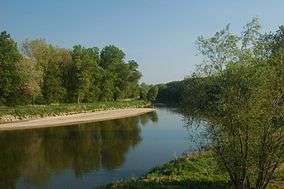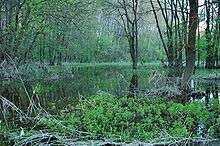Morava (river)
| Morava (March) | |
| Morva | |
| River | |
 | |
| Countries | Czech Republic, Slovakia, Austria |
|---|---|
| Regions | Pardubice, Olomouc, Zlín, South Moravian, Trnava, Bratislava, Lower Austria |
| Tributaries | |
| - left | Krupá, Branná, Desná, Oskava, Bečva, Dřevnice, Olšava, Velička, Myjava |
| - right | Mírovka, Moravská Sázava, Haná, Thaya |
| Cities | Olomouc, Kroměříž, Uherské Hradiště, Hodonín, Bratislava |
| Source | |
| - location | Králický Sněžník |
| - elevation | 1,371 m (4,498 ft) |
| - coordinates | CZ 50°12′18″N 16°50′57″E / 50.20500°N 16.84917°E |
| Mouth | Danube |
| - location | Bratislava |
| - coordinates | CZ 48°10′27″N 16°58′32″E / 48.17417°N 16.97556°ECoordinates: CZ 48°10′27″N 16°58′32″E / 48.17417°N 16.97556°E |
| Length | 354 km (220 mi) |
| Basin | 26,658 km2 (10,293 sq mi) |
| Discharge | |
| - average | 120 m3/s (4,238 cu ft/s) |
| Progression | Danube→ Black Sea |
 | |
The Morava (German: March, Hungarian: Morva, Polish: Morawa) is a river in Central Europe, a left tributary of the Danube. It is the main river of Moravia, which derives its name from it. The river originates on the Králický Sněžník mountain in the north-eastern corner of Pardubice Region, near the border between the Czech Republic and Poland and has a vaguely southward trajectory. The lower part of the river's course forms the border between the Czech Republic and Slovakia and then between Austria and Slovakia.
Geography
The lowlands formed by the river are the Upper Moravian Vale or Hornomoravský úval and then the Lower Moravian Vale or Dolnomoravský úval in Moravia, the Moravian Field or Marchfeld in Lower Austria, and the Záhorie Lowland or Záhorská nížina in Slovakia. The latter three are actually continuous parts of one large basin, forming the major part of the Vienna Basin.
In the Czech Republic, there are some larger towns lying upon Morava, particularly Olomouc, Kroměříž, Otrokovice, Uherské Hradiště and Hodonín. Downstream from here, the river flows along sparsely inhabited, forested border area, all the way to its outfall into the Danube, just below the Devín Castle at the outskirts of the Slovak capital Bratislava. After 354 km of its course, Morava feeds the Danube by an average discharge rate of 120 m3/s, gathered from a drainage area of 26 658 km2. The Morava river is unusual in that it is a European blackwater river.
The river's longest tributary is Thaya (in German) or Dyje (in Czech), flowing in at the tripoint of Austria, the Czech Republic and Slovakia. The biggest tributary from the left is Bečva.
Naming and history
Though the German name March may refer to Mark, "border, frontier" (c.f. English march), the river's name more probably is derived from Proto-Indo-European *mori, "waters" (mare). It was first documented as Maraha in an 892 deed.
Indeed, the lower part of the river, downstream of the confluence with the Thaya at Hohenau an der March, which today marks the Austro-Slovakian border, is one of the oldest national boundaries still extant in continental Europe: it was the eastern boundary of the Carolingian Empire with the Avar Khaganate around 800 and from the 10th century onwards marked the border of the Imperial marcha orientalis, later Duchy of Austria with the Kingdom of Hungary (within the Habsburg Monarchy during 1526–1918 due to the imperial expansion of the Austrian lands). At the times of the Cold War, this section of the river was part of the Iron curtain, being the frontier between Austria and Czechoslovakia.
1997 flooding
In July 1997, the Morava basin (especially its northern and eastern part) was affected by heavy stratiform raining, which lasted several days and caused catastrophic floods also on the Oder River basin in Poland and Germany. In the Czech Republic, 49 people lost their life, more than 250 villages had to be evacuated and the total damage cost 63 billion crowns.
Gallery
- Source of the Morava on Králický Sněžník


 A small pond on the Morava's alluvial plain
A small pond on the Morava's alluvial plain Thaya-Morava confluence - intersection of three borders, Austrian, Czech and Slovak
Thaya-Morava confluence - intersection of three borders, Austrian, Czech and Slovak Flooded forest
Flooded forest
See also
External links
| Wikimedia Commons has media related to Morava River. |
-
 Geographic data related to Morava (river) at OpenStreetMap
Geographic data related to Morava (river) at OpenStreetMap
